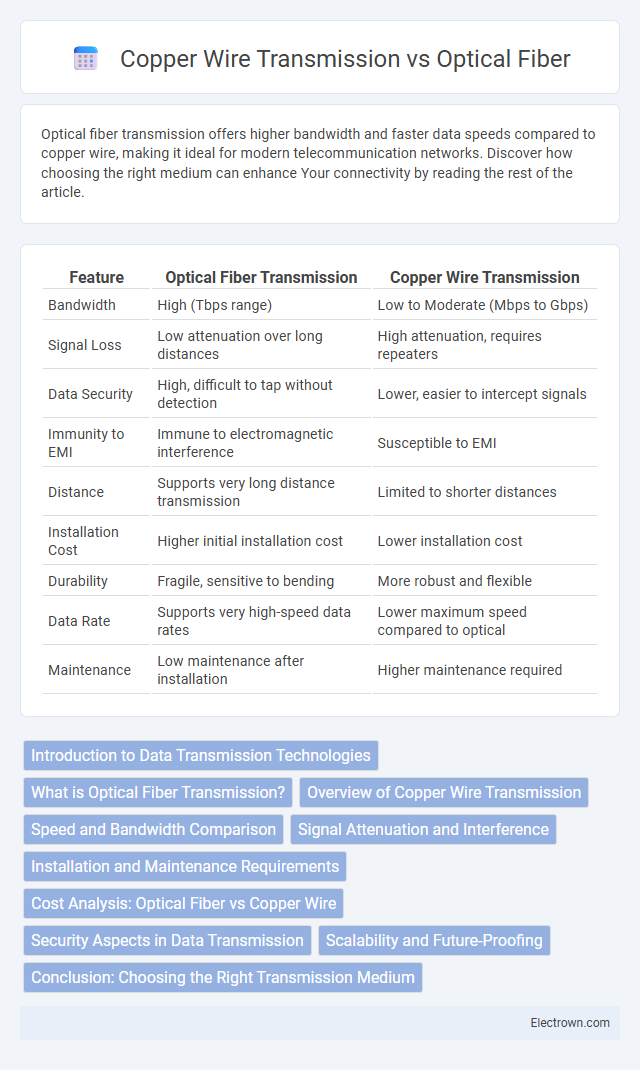Optical fiber transmission offers higher bandwidth and faster data speeds compared to copper wire, making it ideal for modern telecommunication networks. Discover how choosing the right medium can enhance Your connectivity by reading the rest of the article.
Table of Comparison
| Feature | Optical Fiber Transmission | Copper Wire Transmission |
|---|---|---|
| Bandwidth | High (Tbps range) | Low to Moderate (Mbps to Gbps) |
| Signal Loss | Low attenuation over long distances | High attenuation, requires repeaters |
| Data Security | High, difficult to tap without detection | Lower, easier to intercept signals |
| Immunity to EMI | Immune to electromagnetic interference | Susceptible to EMI |
| Distance | Supports very long distance transmission | Limited to shorter distances |
| Installation Cost | Higher initial installation cost | Lower installation cost |
| Durability | Fragile, sensitive to bending | More robust and flexible |
| Data Rate | Supports very high-speed data rates | Lower maximum speed compared to optical |
| Maintenance | Low maintenance after installation | Higher maintenance required |
Introduction to Data Transmission Technologies
Optical fiber transmission uses light signals through glass or plastic fibers, offering significantly higher bandwidth and longer distance capabilities compared to copper wire transmission, which relies on electrical signals through metal conductors. Copper wires, typically made of twisted pair or coaxial cables, are susceptible to electromagnetic interference and signal degradation over longer distances. Optical fiber's superior immunity to interference and minimal signal attenuation make it the preferred choice for modern high-speed data communication infrastructures.
What is Optical Fiber Transmission?
Optical fiber transmission uses strands of glass or plastic fibers to transmit data as pulses of light, enabling high-speed and long-distance communication with minimal signal loss. It offers greater bandwidth capacity, resistance to electromagnetic interference, and enhanced security compared to copper wire transmission. Optical fiber is essential for modern telecommunications, internet infrastructure, and high-speed data transfer networks.
Overview of Copper Wire Transmission
Copper wire transmission relies on electrical signals traveling through conductive metal cables, primarily used in traditional telecommunication and internet infrastructure. It offers cost-effective installation and easy handling but suffers from signal degradation over long distances and is susceptible to electromagnetic interference. Your network's performance using copper wiring depends on factors like cable quality, distance, and shielding effectiveness.
Speed and Bandwidth Comparison
Optical fiber transmission offers significantly higher speeds and greater bandwidth compared to copper wire, supporting data rates up to terabits per second over long distances with minimal signal loss. Copper wire, constrained by electrical resistance and electromagnetic interference, generally maxes out at gigabit speeds for shorter runs, limiting its effectiveness in high-demand network environments. The superior capacity of optical fiber makes it essential for modern high-speed internet, data centers, and telecommunications infrastructure where large-volume data transfer is critical.
Signal Attenuation and Interference
Optical fiber transmission experiences significantly lower signal attenuation compared to copper wire, allowing data to travel longer distances without degradation. It is also highly resistant to electromagnetic interference, ensuring cleaner and more reliable signal quality. Your network's performance will benefit from the superior noise immunity and minimal signal loss provided by optical fiber technology.
Installation and Maintenance Requirements
Optical fiber installation demands precise handling and specialized equipment to ensure proper alignment and splicing of thin glass strands, while copper wire installation is generally less complex with straightforward termination processes. Maintenance for optical fiber involves monitoring for physical breaks and connector cleanliness to sustain high data integrity, whereas copper wire requires regular inspection for corrosion, interference, and insulation damage. Despite higher initial installation costs, optical fiber offers lower long-term maintenance expenses and superior resistance to environmental factors compared to copper wire.
Cost Analysis: Optical Fiber vs Copper Wire
Optical fiber transmission offers lower long-term operational costs due to higher durability, lower maintenance, and superior bandwidth capacity compared to copper wire. Initial installation expenses for optical fiber are typically higher because of specialized equipment and labor, but the reduced signal degradation and scalability lead to cost savings over time. Copper wire systems incur frequent costs from signal boosters and repairs, making them less cost-effective for high-speed, long-distance data transmission.
Security Aspects in Data Transmission
Optical fiber transmission offers superior security compared to copper wire due to its resistance to electromagnetic interference and difficulty in signal tapping without detection. Unlike copper wires, which are vulnerable to interception through inductive or capacitive coupling, fiber optic cables transmit data as light pulses, making unauthorized access significantly harder. This enhanced security makes optical fiber ideal for sensitive data transmission in financial, government, and military communications.
Scalability and Future-Proofing
Optical fiber offers unmatched scalability with significantly higher bandwidth capacity compared to copper wire, supporting the exponential growth in data transmission demands. Its future-proof design enables seamless integration with emerging technologies such as 5G and IoT, ensuring your network infrastructure remains robust over time. Copper wires face limitations in speed and distance, making optical fiber the superior choice for long-term investment in high-performance communication systems.
Conclusion: Choosing the Right Transmission Medium
Optical fiber offers significantly higher bandwidth and faster data transmission with lower latency compared to copper wire, making it ideal for modern high-speed networks. Copper wire remains cost-effective for shorter distances and simpler installations where ultra-high speed is unnecessary. Selecting the right transmission medium depends on factors such as distance, required data rate, budget, and environmental conditions.
Optical Fiber vs Copper Wire Transmission Infographic

 electrown.com
electrown.com